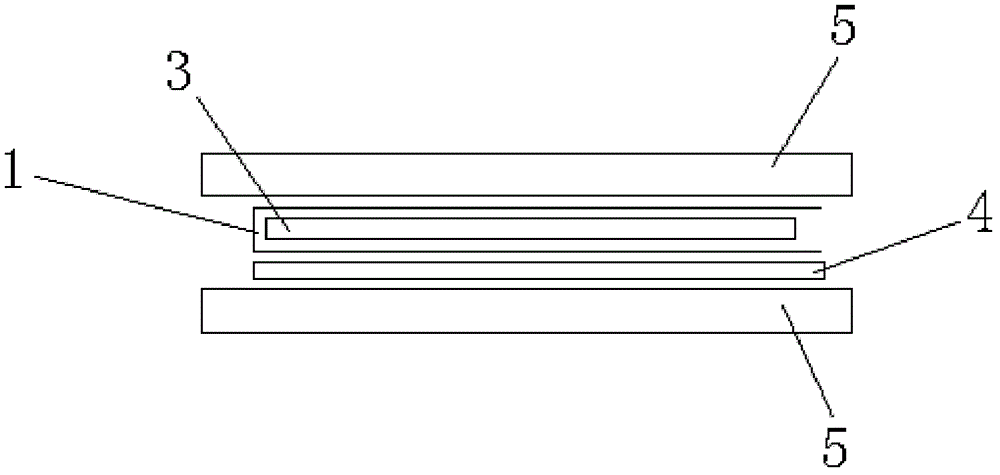Battery diaphragm, manufacturing method of the diaphragm and method of manufacturing battery using the diaphragm
A technology for battery separators and manufacturing methods, which is applied to battery components, chemical instruments and methods, circuits, etc., to achieve the effect of solving the problem of voids and free electrolyte, good uniformity of reaction, and good consistency
- Summary
- Abstract
- Description
- Claims
- Application Information
AI Technical Summary
Problems solved by technology
Method used
Image
Examples
Embodiment 1
[0033] Add polyvinylidene fluoride (PVDF) with a molecular weight of 30-40W into N-methylpyrrolidone (NMP), and dissolve under constant temperature conditions to form a uniform high-molecular polymer solution, and the dissolution temperature is 55-75°C; the high-molecular polymer The weight ratio of each component of the solution is PVDF:NMP=15:100;
[0034] Use a reverse roll coater to coat both sides of the separator with a layer of polymer solution and dry at 100°C. After drying, the thickness of the polymer layer on both sides is 8 μm;
[0035] Use a hot press to heat the positive and negative plates and the diaphragm to melt the diaphragm treatment layer so that the three components of the diaphragm, positive electrode and negative electrode are connected as a whole. The hot pressing temperature is 123°C, the hot pressing pressure is 1.5MPa, and the hot pressing time for 7S.
[0036] The power battery produced according to this embodiment was disassembled under the fully...
Embodiment 2
[0038] Add the mixture of polypropylene and polymethyl acrylate with a molecular weight of 30-40W into N-methylpyrrolidone (NMP), and dissolve under constant temperature conditions to form a uniform high-molecular polymer solution. The dissolution temperature is 60-65°C; The weight ratio of the components of the polymer solution is: polypropylene: polymethyl acrylate: NMP = 10: 10: 100;
[0039] Use a reverse roll coater to coat both sides of the separator with a layer of polymer solution and dry at 110°C. After drying, the thickness of the polymer layer on both sides is 10 μm;
[0040] Use a hot press to hot-press the positive and negative plates and the diaphragm to melt the diaphragm treatment layer so that the three components of the diaphragm, positive electrode and negative electrode are connected as a whole; the hot-pressing temperature is 123°C, and the hot-pressing pressure is 1.5MPa. The time is 7S.
[0041] The power battery produced according to this embodiment wa...
Embodiment 3
[0043] Add polyvinylidene fluoride (PVDF) with a molecular weight of 30-40W into the acetone solution, and dissolve under constant temperature conditions to form a uniform high-molecular polymer solution at a dissolution temperature of 45-65°C; the weight ratio of the components of the high-molecular polymer solution For: PVDF: acetone = 30: 100;
[0044] Use a reverse roll coater to coat both sides of the separator with a layer of polymer solution and dry at 120°C. After drying, the thickness of the polymer layer on both sides is 12 μm;
[0045]Use a hot press to hot-press the positive and negative plates and the diaphragm to melt the diaphragm treatment layer so that the three components of the diaphragm, positive electrode and negative electrode are connected as a whole; the hot-pressing temperature is 123°C, and the hot-pressing pressure is 1.5MPa. The time is 7S.
[0046] The initial battery produced according to this embodiment was disassembled when the battery was full...
PUM
| Property | Measurement | Unit |
|---|---|---|
| thickness | aaaaa | aaaaa |
| thickness | aaaaa | aaaaa |
Abstract
Description
Claims
Application Information
 Login to View More
Login to View More - R&D Engineer
- R&D Manager
- IP Professional
- Industry Leading Data Capabilities
- Powerful AI technology
- Patent DNA Extraction
Browse by: Latest US Patents, China's latest patents, Technical Efficacy Thesaurus, Application Domain, Technology Topic, Popular Technical Reports.
© 2024 PatSnap. All rights reserved.Legal|Privacy policy|Modern Slavery Act Transparency Statement|Sitemap|About US| Contact US: help@patsnap.com









